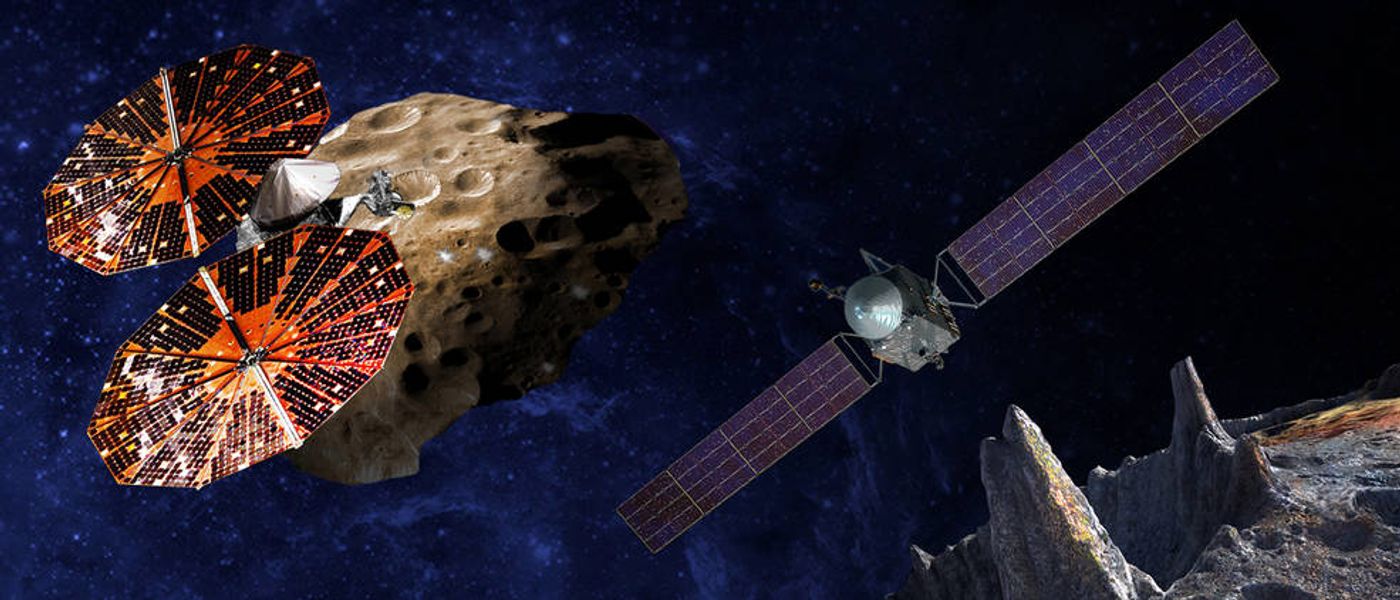NASA Announces New Missions With Two Solar System Targets in Mind
NASA has announced two exciting new Discovery missions that are intended to help us learn more about the Solar System we reside in.
Image Credit: SwRI and SSL/Peter Rubin
Mission One: Lucy
The first mission, Lucy, will be an attempt to learn more about the six Trojan asteroids that are trapped in Jupiter’s gravitational pull and orbit the Sun at the same rate of speed that Jupiter does.
The mission will kick off with a launch in 2021, arriving at its first destination in the middle of the main Asteroid Belt some time in 2025. Afterwards, it will head to its main destination, which involves the six Trojan asteroids from 2027 to 2033.
The three Trojan asteroids are trapped in two different “swarms,” one of which is leading Jupiter, while the other is trailing the giant gas planet. Nevertheless, because they’re trapped along with Jupiter in the Sun’s gravitational pull, they orbit the Sun at the same rate Jupiter does – once every 12 Earth years.
This in itself is quite exiting for astronomers, because these Trojan asteroids are believed to be made up of primordial material, or material that made up the early solar system before the planets were formed. This means we can potentially learn more about what the Solar System was like way before we even came around.
“This is a unique opportunity,” said Harold F. Levison, principal investigator of the Lucy mission from the Southwest Research Institute in Boulder, Colorado. “Because the Trojans are remnants of the primordial material that formed the outer planets, they hold vital clues to deciphering the history of the solar system. Lucy, like the human fossil for which it is named, will revolutionize the understanding of our origins.”
Equipped with more modern versions of the RALPH and LORRI instruments that were instrumental parts of the space discoveries that New Horizons helped bring on its journey to Pluto, Lucy is expected to unveil a wealth of new information about our Solar System.
Mission Two: Psyche
The second mission, being dubbed Phyche, will be tackling an attempt to visit what appears to be a giant metal asteroid in the middle of the asteroid belt. Because it’s a giant metal chunk, it’s believed that it might be the remnant of a failed planet that once existed before intense bombardments by surrounding material knocked off the outer layers of rock. Measuring at around 130 miles in diameter, it’s made up of similar metals as Earth’s core, including iron and nickel.
This mission is expected to shed some light on the metallic asteroid’s past, as well as help us to understand how a planet can part with its outer layers to leave behind just the metallic core. It will launch in October of 2023, arriving at its destination some time in 2030.
“This is an opportunity to explore a new type of world – not one of rock or ice, but of metal,” said Psyche Principal Investigator Lindy Elkins-Tanton of Arizona State University in Tempe. “16 Psyche is the only known object of its kind in the solar system, and this is the only way humans will ever visit a core. We learn about inner space by visiting outer space.”
Both missions are expected to help us answer the deepening questions about the formation of our Solar System and the objects that reside in it. While we have successfully studied a variety of objects in the Solar System already with missions like New Horizons, Juno, and others, there’s still much to learn.
“These are true missions of discovery that integrate into NASA’s larger strategy of investigating how the solar system formed and evolved,” said NASA’s Planetary Science Director Jim Green.
“We’ve explored terrestrial planets, gas giants, and a range of other bodies orbiting the sun. Lucy will observe primitive remnants from farther out in the solar system, while Psyche will directly observe the interior of a planetary body. These additional pieces of the puzzle will help us understand how the sun and its family of planets formed, changed over time, and became places where life could develop and be sustained – and what the future may hold.”
It should be interesting to see what the space agency is able to turn up in terms of new information. After all, these missions will be a few decades in the making, as the objects we intend to search and explore are as much as three times further from the Sun as our Earth, requiring a lot of time to get to and from.
Source: NASA









